Fumes from cured-in-place pipe projects have landed people in the hospital, triggered evacuations and sparked lawsuits. The industry says it's safe.
It hit Kaylie Marley in school.
A strong, epoxy-like odor that nauseated her and dozens of classmates and teachers at Spooner Middle School in Wisconsin. By the time they evacuated, Kaylie was feeling lightheaded. She passed out and was rushed to the hospital by ambulance.
A similar odor struck David Walsh when he returned home from work.
It reminded him of fiberglass resin – a strong, sickening scent that assaulted his nostrils and made his head pound. His wife and two children, who had spent the day in the family’s home in Shoreline, Washington, complained of nausea and headaches. They soon felt so unwell that they packed their bags and left.
Rob Shoaff also was at home when he detected it.
The smell, which he likened to plastic model cement, originated in the basement but soon spread to multiple floors of his three-story house in Harrisburg, Pennsylvania. It irritated his nose and gave him headaches that lingered even after the smell was gone.
Dozens of similar incidents coast to coast have not only triggered headaches, nausea and evacuations but also sparked claims of lasting injuries and even death caused by noxious fumes from an increasingly popular pipeline rehabilitation procedure.
Cured-in-place pipe lining creates a new pipe inside an old one by inserting a soft, resin-soaked liner into a damaged pipe, inflating it with pressurized air, then heating it so it hardens. It costs about eight times less than a traditional pipe rehabilitation project and eliminates the need to dig up streets, reroute traffic or haul away debris. And it has been used on hundreds of millions of feet of underground infrastructure – a figure expected to grow as the nation races to rehab its aging water and sewer lines.
Those efforts are accelerated, in part, by the 2021 Bipartisan Infrastructure Bill, which is providing $50 billion to local governments for water and sewer improvements. Many of those dollars already are flowing to cured-in-place pipe lining projects.
Yet the process carries an inherent public health risk that the industry has downplayed, and government regulators have all but ignored, even as the list of exposures continues to grow, a USA TODAY investigation found.
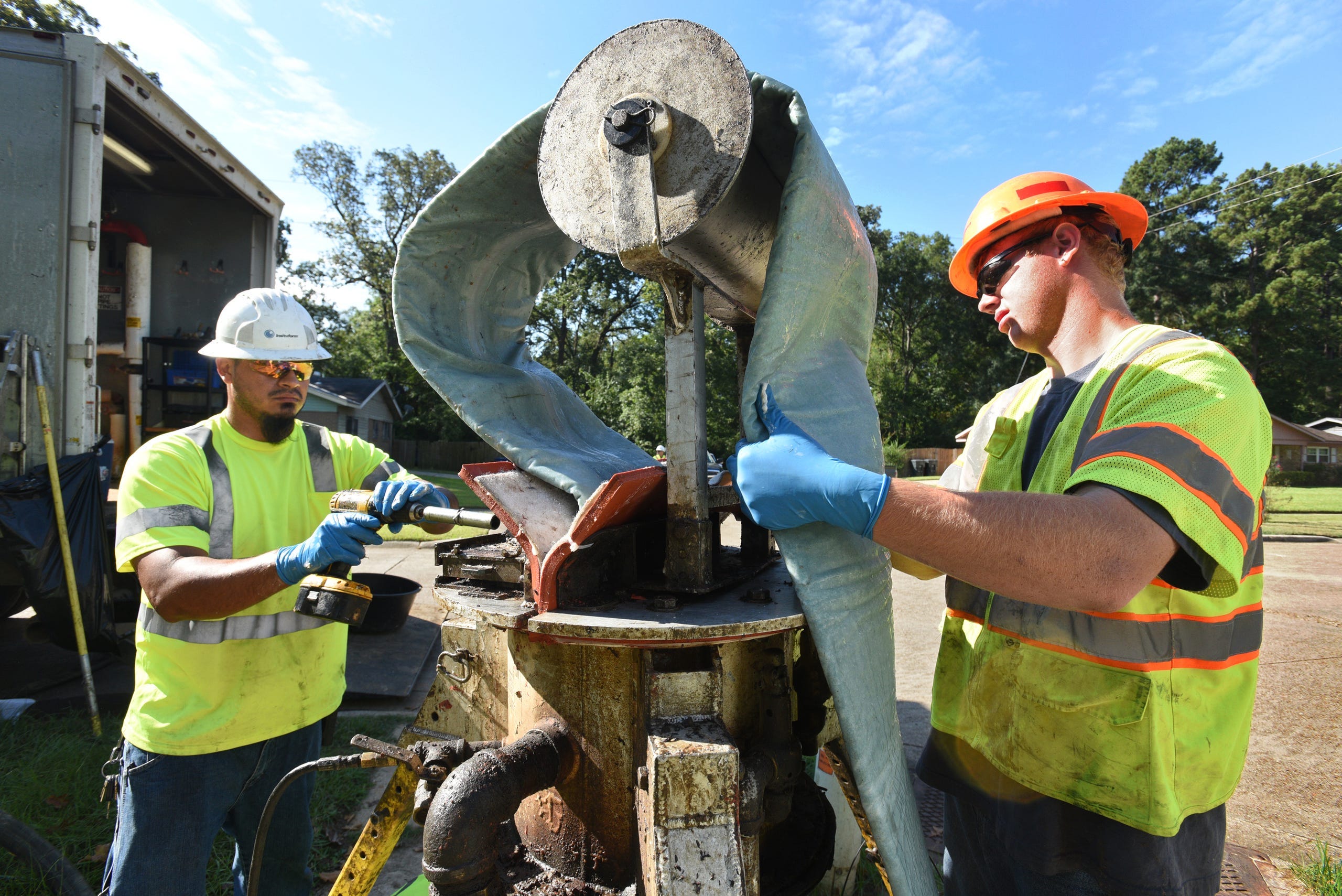
Volatile organic compounds released during the heating process can escape as a chemical plume traveling out of the manholes and through the lateral connections linking the main pipe to the properties it serves.
Inside that plume can lurk styrene, benzene, methylene chloride and phenol, along with bits of uncured resin, partially cured plastic and hazardous air pollutants, according to scientific research funded by the U.S. National Science Foundation and cited by the Centers for Disease Control and Prevention.
Styrene, in particular, is considered a probable carcinogen that, when inhaled, can irritate the eyes, nose and throat. It can also impair the nervous system, inducing dizziness, headaches, slowed reaction times, loss of balance, nausea and unconsciousness, according to the CDC.
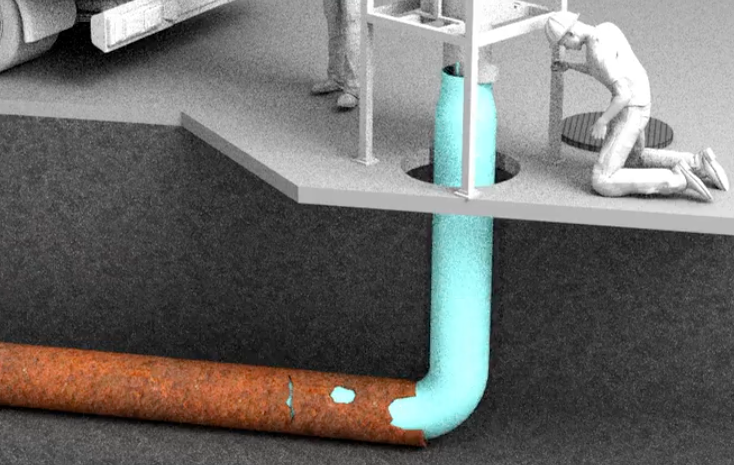
Several people told USA TODAY their symptoms lasted weeks. In some cases, they never went away. Susan Dosier said she developed permanent hearing loss and a ringing in her ear after standing near a pipe lining cloud by her house in Bend, Oregon, in late 2018.
Kaylie, the middle school student, has suffered recurring headaches since the incident at her school in November 2021. Sometimes she gets them twice a week, said her mother, Lauren Marley. Walsh said his daughter also has had frequent headaches since their episode in 2020.
At least three workers in two pipe-lining incidents have died after exposure to the chemicals. One of them was 22-year-old Brett Morrow, who entered a pipe in 2017 to free a stuck, resin-soaked liner. Overcome by styrene, he passed out and drowned, his death certificate shows.
In October, a Florida woman settled a lawsuit with a contractor she blamed for her 71-year-old mother’s death. Nancy Loft alleged that fumes from a 2015 cured-in-place project infiltrated her mother’s Deerfield Beach home, knocked her out and touched off a series of health complications that claimed her life a year and a half later.
Yet the cured-in-place pipe-lining industry is completely unregulated when it comes to public health. No state or federal agency actively monitors work sites or requires safety protocols to eliminate or prevent harmful emissions from leaking into the environment.
“It’s sort of the Wild West,” said Matt Belcher, a Chicago-based attorney who represented Morrow’s family in a lawsuit against several defendants, including the liner manufacturer, that was settled for $3 million in 2021. “Nobody is policing these things.”
The Occupational Safety and Health Administration does regulate the industry with regards to worker safety. It fined Morrow’s employer $77,604 after determining the company violated 15 regulations in connection with his death inside a cured-in-place pipe. But its oversight doesn’t protect the general public.
That leaves the industry responsible for policing itself. And while it has adopted voluntary guidelines to control worksite emissions, it has vigorously rejected evidence of widespread public health risks.
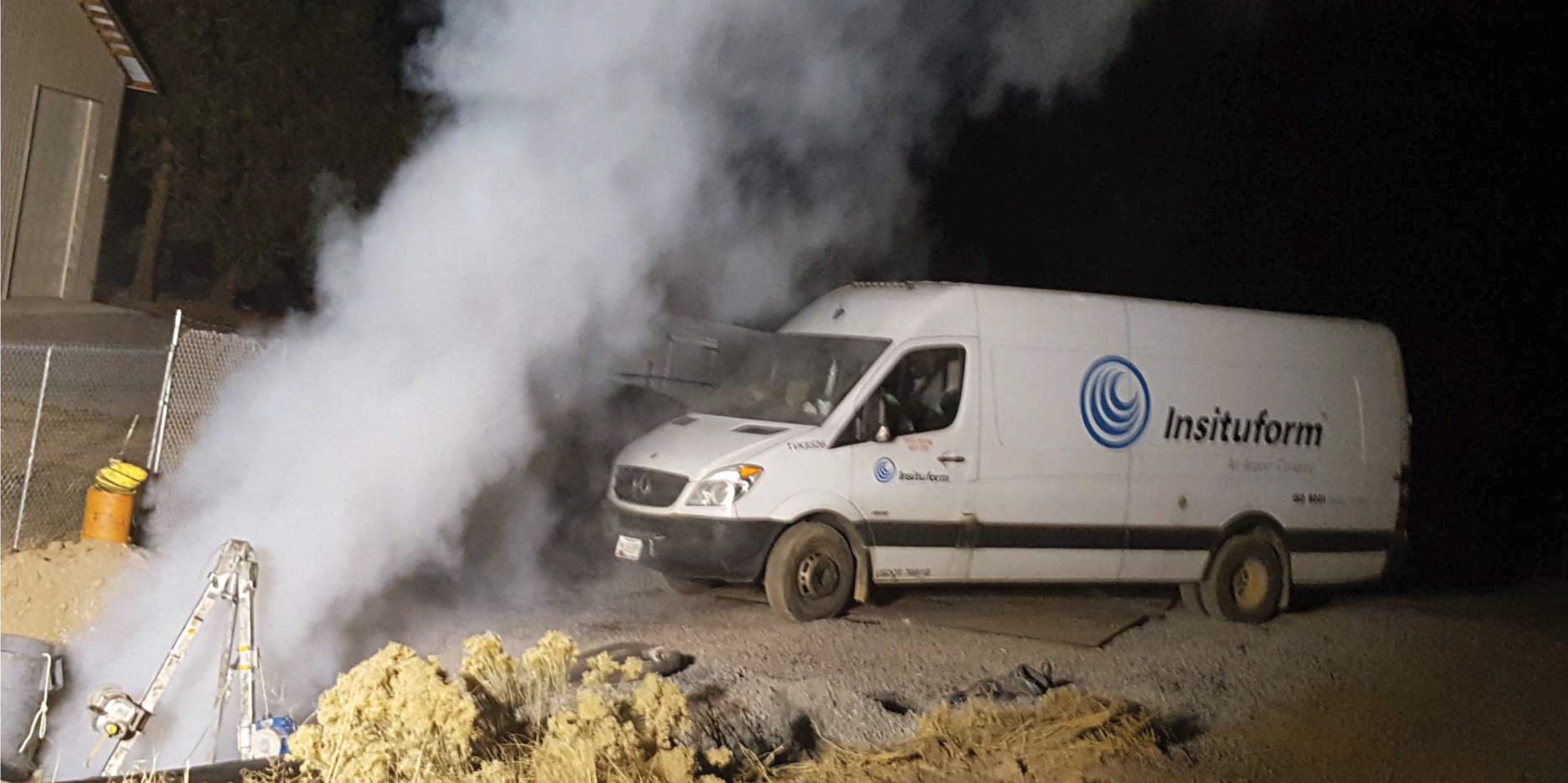
In 2017, the National Association of Sewer Service Companies, whose membership includes cured-in-place pipe contractors, publicly denounced a peer-reviewed study led by Purdue researcher Andrew Whelton that determined the process releases noxious emissions into the air.
The association at the time vowed to fund an independent study “to challenge and/or confirm” the information.” It paid the University of Texas at Arlington’s Center for Underground Infrastructure Research and Education, whose board includes cured-in-place industry members, to review published reports of the process’ health risks. The group concluded in 2018 that the methodologies of those reports were flawed and their results “non-conclusive.”
Whelton said those criticisms lack merit and noted that his team has published numerous peer-reviewed papers about the pipe emissions, some of which received funding from state and federal agencies, including the CDC’s National Institute for Occupational Safety and Health.
His Purdue-sponsored CIPP Solutions Group website also maintains a list of human and environmental incidents, with more than 100 entries across 35 states, many of them related to schools and day care centers.
Sheila Joy, executive director of the National Association of Sewer Service Companies, said in an email to USA TODAY that her group continues to fund research evaluating health risks from cured-in-place pipe emissions and updates its safety guidelines based on those studies. Recent updates include a recommendation to establish a 15-foot perimeter around the manholes where emissions exit and to provide additional personal protective gear for people who work closely with the chemicals.
Joy also pointed to a one-page document the group created for the general public explaining how to eliminate or minimize fumes from such projects.
Called “What’s That Odor,” the document seeks to reassure people by noting that styrene occurs naturally in the environment – and says that just because you can smell it, doesn’t mean it’s dangerous.
But Whelton said his research shows otherwise. Both styrene resin and non-styrene resin emissions pose health risks to humans and animals, he said. If the industry won’t invest in technology to contain the fumes, he said, the government needs to step in and order it.
“There are ways to use CIPP responsibly and safely, but currently, cities, municipalities and the industry embrace this dirty process for allowing waste to leave the worksite and harm other people,” he said. “The practice is inherently dangerous because there are no controls. Are you going to get a car with a seatbelt or no seatbelt?”
From a mushroom farm to the sewer
Cured-in-place pipe lining started, oddly enough, on a mushroom farm.
A leaky air duct over a bed of growing fungi didn’t easily lend itself to repair. So English agricultural engineer Eric Wood decided to create a new duct inside the old one by inserting a resin-soaked liner, inflating it with air and leaving it to cure.
Wood’s solution worked so well that he patented the process and started a company, Insituform – from the Latin phrase “to form in place.” Its first municipal project was in 1971 in East London, where Wood rehabilitated a 230-foot-section of a century-old sewer for the Thames Water utility company.
Since then, the industry has exploded into a constellation of major contractors and countless mom-and-pop operations. Today, they comprise a global market that was valued at nearly $2 billion in 2020 and is expected to reach $3 billion by the end of the decade – with the United States its biggest customer base.
Clients have included the U.S. Army Corps of Engineers, which contracted the relining of a 120-inch storm sewer underneath McGuire Air Force Base in New Jersey; Culver City, California, for the relining of an aging wastewater pipeline; and the Maryland Transportation Authority, for the restoration of the Baltimore Harbor Tunnel fire suppression system.
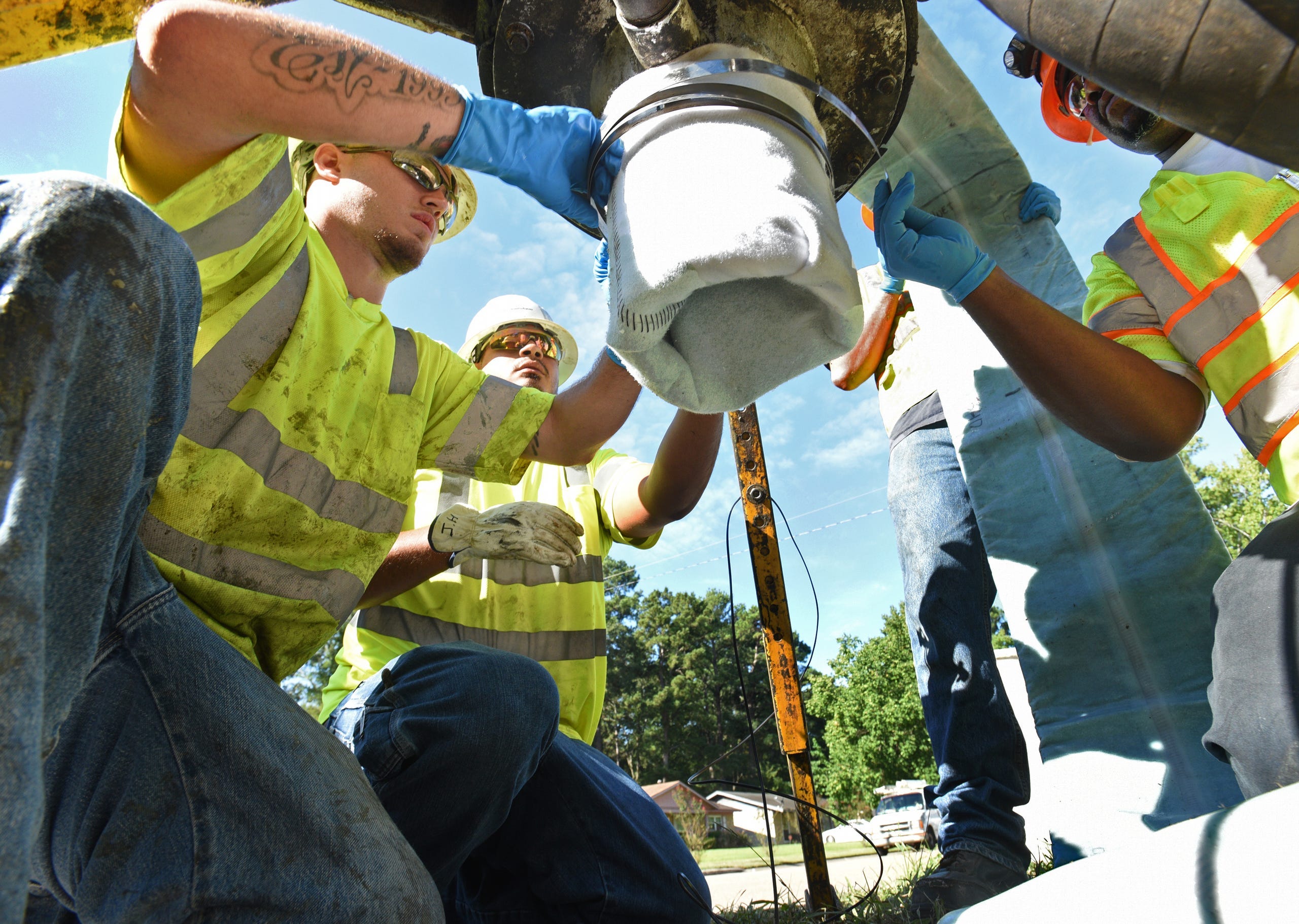
The process involved in these projects is largely the same, although the specific types of resins, fabrics and curing methods can vary. The most popular of these materials and methods, though, are also the most prone to harmful fumes.
Polyester-resin soaked liners contain more volatile organic compounds than other resins and, during the curing phase, release more hazardous air pollutants. But polyester resin is cheaper and works just as well as other resins for most sewer and stormwater projects, so it’s typically the top choice.
And of the three main curing methods – UV light, hot water and steam – steam dominates the market because of its easier setup, quicker drying time and stronger finished product. It also produces the most emissions.
That these emissions don’t automatically infiltrate every dwelling is thanks to a plumbing feature commonly called the P-trap. This U-shaped bend in the pipes under most sinks and toilets is designed to trap enough water from daily washes and flushes to effectively block fumes from the sewer from entering a structure.
Drains aren’t the only way for fumes to enter a building. They can seep in through cracks in the foundation, doors, windows and air intakes.
But even drains are not a fail-safe.
Some older buildings lack these U-shaped traps. And water can evaporate from the traps of rarely used sinks, toilets and bathtubs, clearing the path for fumes to enter and spread.
Even when the traps are full, pressurized steam or liquid from cured-in-place pipe projects can blow the standing water out of toilets and drains. That’s what happened to Courtney Hirsch, of Harrisburg, Pennsylvania, during a pipe relining project in January 2020.
Multiple times during the project, Hirsch said, a “sudden rocket of water” would blast up from her toilet and spray water and old toilet paper everywhere. Her house smelled like burnt plastic for weeks, she said, causing her severe headaches, nosebleeds and eye irritation.
“They told us to put water in our drains, but that didn’t work,” she said. “They also told us the odor was safe, but if I’m experiencing all these symptoms, I don’t think it’s safe.”
'Sweep it under a rug'
People may get little to no warning of the dangers.
Mailers, door hangers and FAQs alerting residents to these projects tend to omit, deny or downplay the potential health threats, according to a USA TODAY review of more than a dozen such communications.
A public notice issued last year by the Town of Canton, Connecticut, said ahead of a sewer relining project that a glue or fiberglass odor “may get into the building through improper or clogged venting, dry traps, or, in some older homes, floor drains that are connected to the sanitary sewer. If you detect an odor, please ventilate your home by opening a window.”

Then, in bolded and underlined text, it continued, “The odor is not harmful and will dissipate quickly.”
A door hanger left in 2015 by Insituform in Deerfield Beach, Florida, advised residents to pour water into floor drains and rarely used sinks, tubs and toilets to prevent odors from entering the home. If that doesn’t work, it said, the trap may require repair.
“You may need to temporarily place plastic bags filled with water over the drain to prevent the backflow of odors or open windows to allow ventilation,” the door hanger said. “If you continue to smell odors, please call the Insituform representative.”
When people do call the company, they’re typically told not to worry, said former Insituform employee Anthony Perez, who spent about three years on a crew in Littleton, Colorado. He remembers counseling residents there about the chemical smell.
“We were told to tell the person that you may get a headache, but we’re around it every day, and we’re OK,” he said, adding that was what the company told its employees, too. “They basically just said, ‘It’s safe.’ The culture seemed to be: ‘We’re tough, we can handle it. Don’t be the one to whine about its effects.’”
Since leaving the industry, though, Perez, now 40, has developed severe emphysema and COPD despite having never smoked cigarettes. He said doctors can’t figure out why his lungs are visibly scarred and failing. But he believes his problems were caused by regular exposure to high concentrations of styrene and other chemicals on the job, which required him to crawl into manholes when the pipe was still hot to cut the ends of the line.
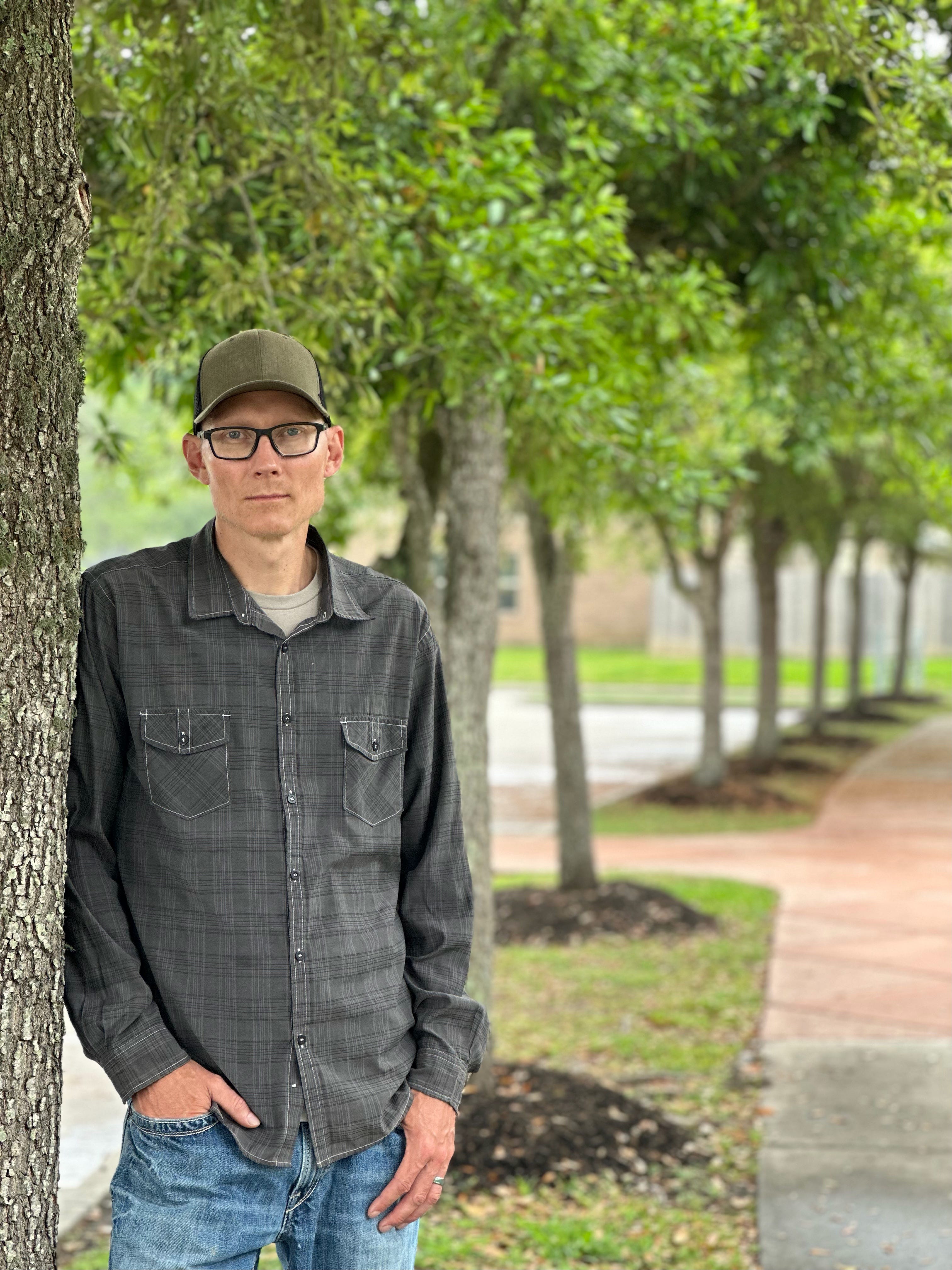
“I can remember times being in the manhole where the vapor was so thick I couldn’t see my hand in front of my face – in there with no respiratory protection,” he said.
“The industry is like, ‘Sweep it under a rug.’”
Aegion Corporation, the parent company of Insituform, did not respond to emails and voicemails seeking comment for this story.
A FAQ from the Sacramento Area Sewer District said that while “unpleasant for some,” the odor from a cured-in-place pipe project is not harmful and “air emissions associated with the project meet all local, state, and federal requirements for the protection of public health.”
That’s at odds with a 2017 California Department of Health safety alert noting that the emissions contain potentially toxic chemicals and advising that cities and contractors “should not tell residents the exposures are safe.”
“Persons who detect an odor and experience health symptoms near CIPP installation sites should contact their medical provider and local health department,” the alert said.
The Florida Department of Health issued a similar statement in a fact sheet in 2020.
Yet when Rob Shoaff called his health department after pipe-lining fumes filled his Harrisburg home, he said, nobody there knew what he was talking about.
“They weren’t sure how they could even do anything,” said Shoaff. “I was asking them if they could come out and test and document it. There was nobody testing. That was my biggest gripe – no one was monitoring it to find out to what extent it was affecting people.”
The work was part of a sewer pipe rehabilitation project contracted out by the municipal utility authority, Capital Region Water. After Shoaff and several other residents complained about the strong smell, the utility issued a notice saying the odor “does not pose a significant risk to human health.” It advised them to add water to their drains and open their windows – even though temperatures that January hovered around 40 degrees.
When opening the windows didn’t work, Shoaff said, he called Capital Region Water again. The utility sent representatives to his house and brought in a portable air filtration device called an air scrubber to try to eliminate the odor, records show.
It also issued a temporary stop order on the work to investigate the situation, and afterward it decided to not use the same type of steam-cured resin liner in the future, the utility’s community relations manager, Steven Early, told Shoaff in a March 2020 email.
Shoaff said he was thankful for the remediation efforts but astounded by what he considered a lack of planning.
“Most of this neighborhood is older houses designed way back when there were no traps to seal out any smells,” Shoaff said. “They could have researched that.”
Utility spokeswoman Rebecca Laufer told USA TODAY that Capital Region Water considers public health and safety, as well as industry best practices, when planning pipe rehabilitation projects. Its construction coordinator also obtained training and certification in so-called trenchless pipe technology to be able to understand and inspect projects.
After a few days with the air scrubber running in his house, Shoaff said, the odor disappeared – and eventually so did his symptoms.
Sometimes, though, an air scrubber won’t cut it.
Family told to get out of the house
Nestled along the Puget Sound just north of Seattle, the city of Shoreline, Washington, hired Insituform in June 2020 to repair more than a half-mile of damaged stormwater pipe.
Five months later, on Nov. 4, a crew appeared at a manhole outside the Walsh residence and began blowing steam into a polyester resin-soaked liner snaking through the pipe under the neighborhood. A strong odor soon filled the house.
While David Wash and his wife, Eilee, stuck it out at home, their children couldn’t stand the smell and spent the night at friends’ houses. The next morning, Eilee called the city, which sent an employee. He didn’t smell anything, city records show.
But the Walshes smelled it.
On the second day, Eilee contacted an industrial hygienist who told her to get out of the house. Eilee immediately relayed the information to city project manager Lea Bonbrake.
“Shoreline hired the work to put the chemical into the system, the city caused the problem, and the city should protect our health until the odor is gone by putting us up in another place to live,” Eilee told Bonebrake in an email Nov. 6, 2020, obtained through a public records request by USA TODAY.
Shoreline agreed, but neither party had anticipated the time, cost or effort it would require to properly decontaminate the family’s home.
For the next two months, the Walshes stayed in a series of hotels and vacation rentals while the city employed a variety of methods to fully mitigate the odor.
It hired a company to run air scrubbers in the house. It sent in professional cleaners to remove the odor from the rugs and furniture. It had charcoal filters installed. It sprayed pressurized water into the newly refurbished pipe to see if that would reduce the smell.
Shoreline also hired a certified industrial hygienist, Barbara Trenary, to conduct several rounds of air testing in the home.
The first test, which was done the day of Eilee’s Nov. 6 email to Bonebrake, showed styrene concentrations that hit the limits of the air detector at 58 parts per billion. The “actual concentration is significantly above the value reported,” the analytical report noted.
The level, however, was below the long-term exposure ceiling set by the National Institute for Occupational Safety and Health, the federal agency that makes recommendations to prevent work-related injuries. It deems safe styrene concentrations under 50 parts per million for long-term exposure and 100 for short-term. That’s also the limit set by the industry itself.
The Walshes had been in the house for two days. Before they left, Eilee had started to experience vertigo and was feeling intoxicated, she told the city in an email. Even the family cat had trouble keeping its balance, she said.
The next air test, done six days later, showed the styrene concentration had dropped to 21 ppb. The city agreed to continue paying for the family’s lodging while doing more cleaning.
Each subsequent test – done 10 days to three weeks apart – revealed a continual drop: first 6.7 ppb, then 1.3 and finally, three days after Christmas, 0.4. In emails, the city used the results to encourage the Walshes to return home.
But the family wouldn’t budge until the city paid for an independent consultant to review the results and declare the levels safe.
“There was a lot of back-and-forth about it, a lot of, ‘Oh, we’re not going pay for your lodging after such-and-such a date,’ and it was like, we said, ‘No, we’re going to get our own lawyer if you don’t take care of this,” David Walsh said.
At one point, he even emailed the mayor requesting a meeting to ensure the city would honor its obligations. The request was denied.
City officials, meanwhile, consulted with their own legal team and a third-party environmental firm. That firm, Floyd|Snider, reviewed the testing results and, on Jan. 5, 2021, gave the Walshes the green light to return home.
The ordeal cost Shoreline more than $75,000 in lodging, testing, cleaning, consulting and legal fees, according to city invoices. That’s on top of the nearly $400,000 contract with Insituform.
It was the first and only time the city had a situation like that, said Shoreline spokesman Eric Bratton. Previous cured-in-place projects had generated a handful of odor complaints, he said, but not to the same degree. Asked if Shoreline has done any cured-in-place projects since then, Bratton said no.
David Walsh called the ordeal a good case study for why the process needs regulation.
“This was an unacceptable health and safety exposure to my family,” he said. “So, yeah, I think it needs to be regulated – really, really needs to be regulated and needs to be regulated by probably a federal agency, not at a local or even a state level.”
'I urge you to prevent harm'
The U.S. Environmental Protection Agency is responsible for protecting the public from harmful emissions, and it already regulates one industry that uses the same chemicals found in cured-in-place pipe lining: boat manufacturing.
Fiberglass boat manufacturing in particular uses resins that contain styrene, which is emitted into the environment during three phases: mixing, application of a gel coat and curing.
The EPA has long recognized styrene as a hazardous air pollutant, belonging to a group of polymers and resins that “can cause reversible or irreversible toxic effects following exposure.”
Under its National Emission Standards for Hazardous Air Pollutants rule, boat manufacturers must limit styrene emissions to a threshold calculated for each operation. They also must demonstrate compliance by monitoring, testing, record-keeping and reporting their results to the EPA.
Boat manufacturing is a fixed-place operation, which makes it more feasible to regulate than the countless cured-in-place pipe projects happening across the country on any given day.
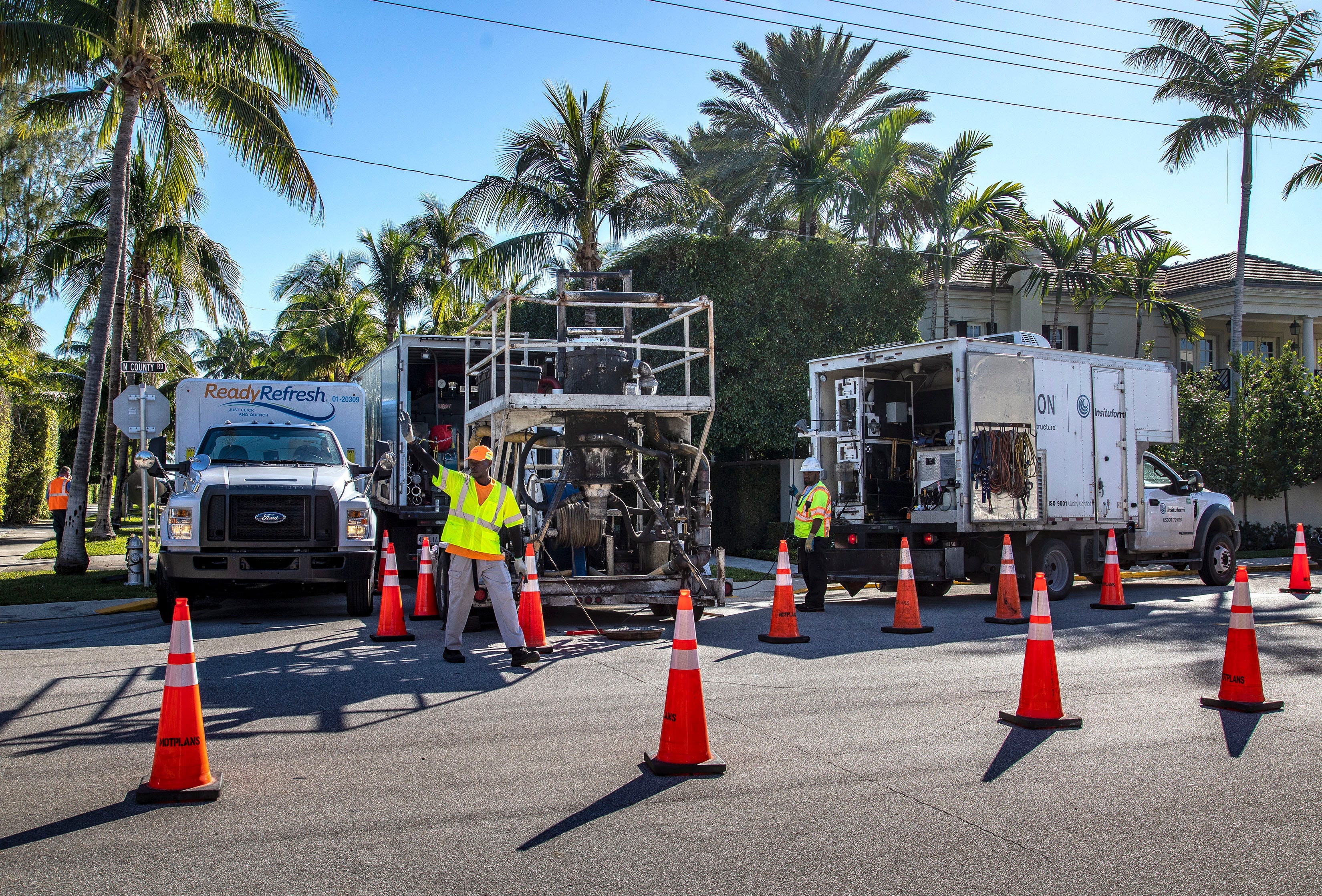
“In boat manufacturing facilities, it’s always the same, day after day, and you always have a street address,” said Whelton, the Purdue researcher. “For CIPP, you drive around the country going to different cities and encounter different environments.”
The EPA typically does not regulate temporary sources of air pollution, agency spokeswoman Melissa A. Sullivan told USA TODAY in an email, adding that it’s not clear that cured-in-place pipe processes would meet the definition of a “major stationary source,” such as boat manufacturing.
“The Cured-In-Place-Piping (CIPP) process does not appear to be covered by any current source categories of national emission standards for hazardous air pollutants,” Sullivan said.
However, Whelton said the EPA has authority under the Clean Air Act and the Clean Water Act to force standards upon these “pop-up” operations. He urged EPA Administrator Michael S. Regan to regulate the industry in a pair of letters sent in March 2021 and again in February 2022.
He said an EPA employee later suggested he contact the CDC instead, but when he did, the CDC told him it’s a local issue.
In the absence of EPA oversight, municipalities hiring these contractors won’t impose their own rules because it can cost them money, Whelton told Regan in his letters, which he also shared with several members of Congress.
“I urge you to prevent harm to bystanders and the environment,” Whelton wrote in one of the letters before ticking off a list of styrene exposures that have affected the health of children.
Among them was the Spooner Middle School incident that had sickened Kaylie.
Work on that project was done by Michels Corporation, a Wisconsin-based construction company with a global footprint and owned by a politically connected family. One of its three co-owners, Tim Michels, ran for governor of Wisconsin last year on the Republican ticket, winning the endorsement of former President Donald Trump but losing in the general election.
Spooner was not the first school-related incident linked to Michels Corporation.
In October 2018, fumes from a job site sickened two teachers at Riverview Elementary in Vancouver, Washington, according to an incident report. Both sought medical treatment after feeling lightheaded and vomiting. None of the children reported symptoms.
Workers from Michels said they had never had any problems and were surprised to hear about the problems at the school, the report noted.
When it happened three years later at Spooner, the impact was more severe.
Sixty-four students and teachers fell ill after the odor seeped into the building around 9:30 a.m., triggering pandemonium and ultimately an evacuation. Parents showed up after school to pick up their kids, only to scramble to find them.
“So many had been taken to the hospital, even across state lines, and we weren’t told,” said Kaylie’s mother, Lauren Marley. “When I finally located her, my baby was incoherent, hooked up to machines. She didn’t even recognize me; she looked lifeless.”
Officials closed the school building for more than a month as officials first tried to identify the source of fumes, then spent weeks airing it out and testing for safety.
Since then, several parents, including Marley, have hired Milwaukee-based attorney Randall Rozek to represent them against the school, the city and the contractor for injuries they blame on the exposure. Those injuries include frequent headaches, anxiety and possible brain damage, according to a notice of a claim sent to the defendants. The lawsuit has not yet been filed, however, the attorney’s office told USA TODAY.
Spooner Fire Chief Darren Vik said a multi-agency investigation was unable to determine the source of the odor, which had dissipated by the time testing occurred. The city never had problems with the procedure in the past, said Spooner Administrator William Marx, and officials just opened bids this week on another cured-in-place project.
Michels Corporation did not respond to emails and voicemails seeking comment for this story. Spooner Area School District Superintendent David Aslyn declined to comment, citing the litigation.
While the city has moved on, Marley said she and her daughter cannot. She said she’s upset that nothing has been done to prevent these situations from happening and that her daughter is paying the price.
“I’m pissed off that that she’s not OK and still has headaches,” Marley said. “We’re worried about the long term.”